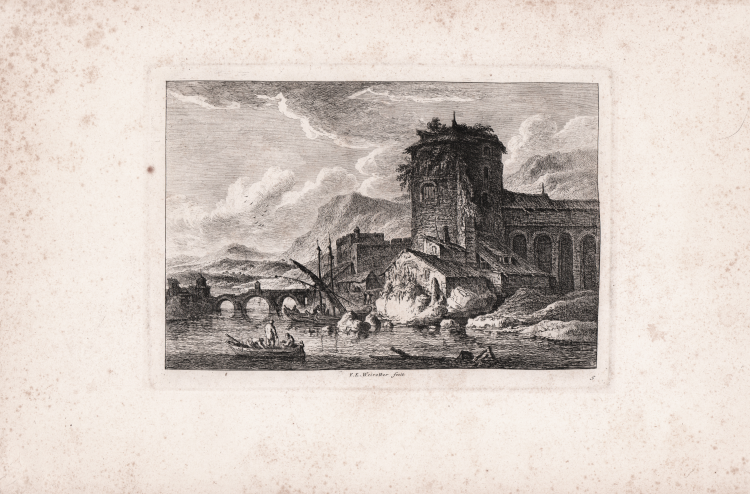



| Reference: | S1605 |
| Author | Franz Edmund WEIROTTER |
| Year: | 1759 ca. |
| Measures: | 235 x 165 mm |


| Reference: | S1605 |
| Author | Franz Edmund WEIROTTER |
| Year: | 1759 ca. |
| Measures: | 235 x 165 mm |
Three fishermen on rowing boats in the foreground; view of a town, a windmill and bridge in the distance.
Etching, circa 1759-63, signed at the bottom. A fine impression, printed on laid paper, with margins, very good condition.
Weirotter was an Austrian painter, draughtsman and etcher. After training in Innsbruck and Vienna, he worked for Elector Johann Friedrich of Mainz, producing ten overdoors for his palace in Mainz, besides landscapes, architectural views and naval and maritime scenes. Joining the pupils of Jean-Georges Wille in Paris in 1759–63, he transferred his ambitions to drawing and printed graphics, practised copying Dutch and Flemish works and developed a masterly etching technique, which he applied to his own drawings. His landscape series, mostly comprising six or twelve small-format etchings, in only a few cases dated or signed on the plate, were published by Wille, François Joullain, Gabriel Huquier, Prevost, François Chéreau I and Basan & Poignant, sometimes in several editions. Visiting Rome in 1763–4, Weirotter met Johann Joachim Winckelmann (1717–68) and Henry Fuseli; he then returned to Paris. In 1767 he was appointed professor of landscape drawing at the Vienna Akademie, through the mediation of his friend Jacob Mathias Schmutzer (1733–1811). He published etchings of ruins from his Italian journey in editions with lavish dedication sheets. After Weirotter’s death Basan & Poignant published a large folio volume, the Oeuvres de F.-E. Weirotter, with 215 graphic works.
Bibliografia
Winterberg 1998 / Franz Edmund Weirotter, der Landschaftsradierer.
Franz Edmund WEIROTTER (Innsbruck, 1733 - Vienna, 1771)
|
Austrian painter, draughtsman and etcher. After training in Innsbruck and Vienna, he worked for Elector Johann Friedrich of Mainz, producing ten overdoors for his palace in Mainz, besides landscapes, architectural views and naval and maritime scenes. Joining the pupils of Jean-Georges Wille in Paris in 1759–63, he transferred his ambitions to drawing and printed graphics, practised copying Dutch and Flemish works and developed a masterly etching technique, which he applied to his own drawings. His landscape series, mostly comprising six or twelve small-format etchings, in only a few cases dated or signed on the plate, were published by Wille, François Joullain, Gabriel Huquier, Prevost, François Chéreau I and Basan & Poignant, sometimes in several editions. Visiting Rome in 1763–4, Weirotter met Johann Joachim Winckelmann (1717–68) and Henry Fuseli; he then returned to Paris. In 1767 he was appointed professor of landscape drawing at the Vienna Akademie, through the mediation of his friend Jacob Mathias Schmutzer (1733–1811). He published etchings of ruins from his Italian journey in editions with lavish dedication sheets. After Weirotter’s death Basan & Poignant published a large folio volume, the Oeuvres de F.-E. Weirotter, with 215 graphic works. Of equal importance are c. 250 drawings in silver point, red chalk or charcoal, many with a sepia or bistre wash, sometimes giving virtually a watercolour effect. Few works can be documented as belonging to his small output of oil paintings.
|
Franz Edmund WEIROTTER (Innsbruck, 1733 - Vienna, 1771)
|
Austrian painter, draughtsman and etcher. After training in Innsbruck and Vienna, he worked for Elector Johann Friedrich of Mainz, producing ten overdoors for his palace in Mainz, besides landscapes, architectural views and naval and maritime scenes. Joining the pupils of Jean-Georges Wille in Paris in 1759–63, he transferred his ambitions to drawing and printed graphics, practised copying Dutch and Flemish works and developed a masterly etching technique, which he applied to his own drawings. His landscape series, mostly comprising six or twelve small-format etchings, in only a few cases dated or signed on the plate, were published by Wille, François Joullain, Gabriel Huquier, Prevost, François Chéreau I and Basan & Poignant, sometimes in several editions. Visiting Rome in 1763–4, Weirotter met Johann Joachim Winckelmann (1717–68) and Henry Fuseli; he then returned to Paris. In 1767 he was appointed professor of landscape drawing at the Vienna Akademie, through the mediation of his friend Jacob Mathias Schmutzer (1733–1811). He published etchings of ruins from his Italian journey in editions with lavish dedication sheets. After Weirotter’s death Basan & Poignant published a large folio volume, the Oeuvres de F.-E. Weirotter, with 215 graphic works. Of equal importance are c. 250 drawings in silver point, red chalk or charcoal, many with a sepia or bistre wash, sometimes giving virtually a watercolour effect. Few works can be documented as belonging to his small output of oil paintings.
|